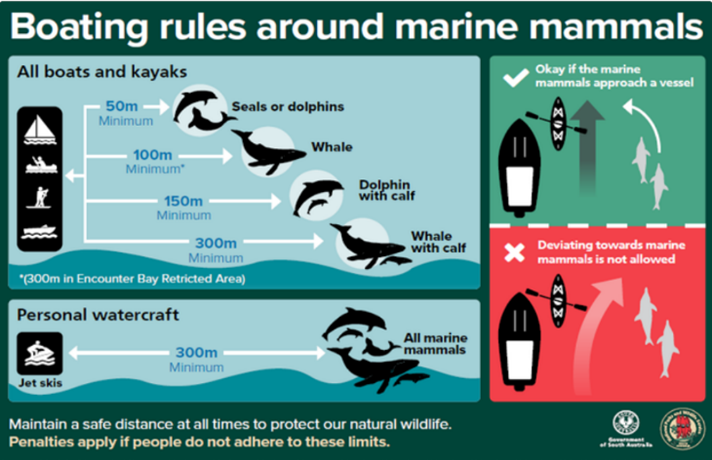4.6 Marine Mammals
Purpose
To provide guidance regarding operating close to marine mammals, including whales and dolphins.
Overview
SLSSA is committed to ensuring the safety and protection of marine mammals. All personnel are required to follow the outlined guidelines to respect and preserve these species.
Compliance with these regulations not only fulfills legal obligations but also supports the conservation of marine life.
Procedure
Both state and federal laws protect whales and dolphins, including the distances that boats, swimmers and aircraft may approach. The relevant state legislation, administered by the Department of Environment and Water, is the National Parks and Wildlife Act 1972 and the National Parks and Wildlife (Protected Animals - Marine Mammals) Regulation 2010.
When operating a non-powered craft (including rescue boards), SLSSA members must maintain the minimum distance from the following marine species / groups:
- 50 metres (m) from dolphins;
- 100 m from whales;
- 150 m from dolphin with calf; and
- 300 m from whale with calf.
Powercraft, including rescue vessels, are to remain at least 300 m all marine mammals at all times.
It is OK for a marine mammal to approach a vessel, but deviating towards marine mammals is not allowed.
Encounter Bay
Within the Encounter Bay Marine Park all vessels and persons must keep a distance of 300 m from any marine mammal. Further information can be found at the National Parks and Wildlife Service.
Port River
Speed limits are in place for parts of the Adelaide Dolphin Sanctuary for the protection of all water users and marine life. Limits of four knots and seven knots are signed throughout the area.

Actions on encountering a stranded or deceased marine mammal
Upon discovering a stranded or deceased mammal (such as a dolphin, seal, or whale) within a patrolled area or nearby shoreline, SLS personnel should immediately assess the situation. Ensure the status of animal and take note of its location, size, and any visible signs of injury or unusual circumstances.
If the mammal is on the beach or in shallow water, secure the area by cordoning off a reasonable perimeter around the animal. Ensure that members of the public are kept at a safe distance to prevent any interference or potential health risks.
As soon as the area is secure, immediately contact the State Operations Centre (SOC) to report the discovery of the mammal. Await instructions from the SOC on the appropriate course of action. This may include:
- Further securing the area / crowd control.
- Assisting with the arrival of relevant authorities (e.g., wildlife officers, marine biologists).
- Providing additional information as required.
Unless directed by the SOC or onsite authorities, do not attempt to handle the marine mammal.
This document must not be displayed, including in a patrol room, or reproduced in any form, without permission from the Lifesaving Department, Surf Life Saving SA.